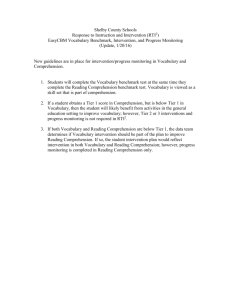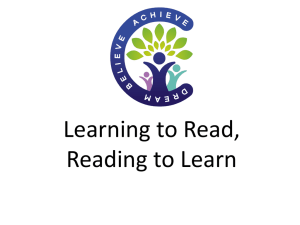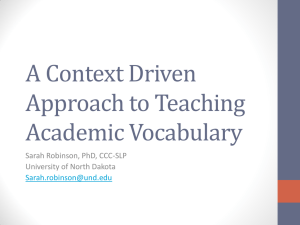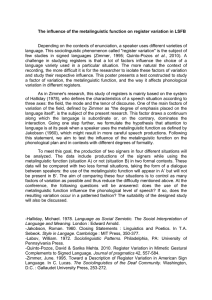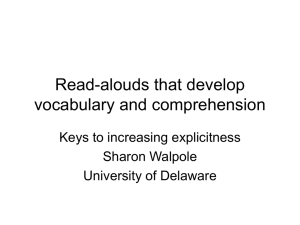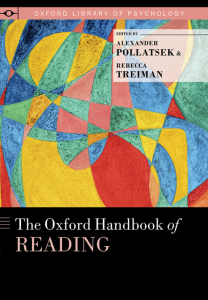A Way With Words: Strategies for Vocabulary Development
advertisement
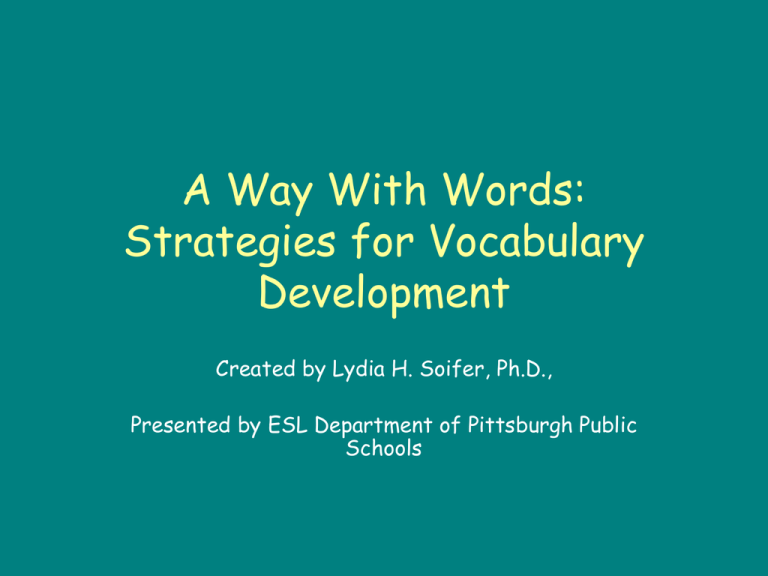
A Way With Words: Strategies for Vocabulary Development Created by Lydia H. Soifer, Ph.D., Presented by ESL Department of Pittsburgh Public Schools About Word Learning and Knowledge • Word consciousness – A metalinguistic skill • • • • Word knowledge is complex Word learning is incremental Words are heterogeneous Definitions, context, word parts – Important – Inherent limitations Vocabulary Knowledge and School Success: Some Connections • Reading comprehension, decoding, spelling • School achievement in general • Builds linguistic awareness • Enhances world knowledge • Influences conceptual and inferential reasoning Good readers and poor readers • Good readers – More efficient phonological representations – Stronger lexical knowledge • Poor readers – Poorer phonological memory – Slower, less efficient word acquisition – Greater difficulty retaining and accessing phonological representations – Decoding difficulty The “Matthew” Effects (Stanovich, 1986) • Students with word reading difficulties: – Read fewer and easier books – Have trouble “decoding” less familiar words – Learn fewer words through reading – Show increasing problems in vocabulary and comprehension How many words do we know? • Average first grader – 6,000 words • Average high school senior – 45,000 words • The Math: – 39,000 words over 12 years – About 3,000 words a year or 10 words a day • The range: – 1,000 words a year for low achieving children – 5,000 words a year for high achieving children Model of vocabulary acquisition (Litowitz, 1971) • Stage 1 – Non-verbal or verbally semantically “empty” • Stage 2 – Responds with word associated to original stimulus word • Stage 3 – Concrete example of experience associated with the stimulus word • Stage 4 – Demonstrates awareness of definition form • Stage 5 – Pure definitional form Four Stages of Knowing a Word (Dale, 1965) • Stage 1 – Never saw/heard it before in my life! • Stage 2 – Heard it, but don’t know what it means. • Stage 3 – I recognize it in context or it has something to do with… • Stage 4 – I know it and can use it properly! Qualitative Dimensions of Word Knowledge (Cronbach, 1942) • • • • • Generalization Application Breadth Precision Availability Goals of a Lexical Learning Program • To improve lexical knowledge and flexibility • To improve word sense • To improve reading comprehension and written language • To improve word retrieval • To develop strategies for vocabulary organization • To develop a lifelong love of words What does it mean to KNOW a word? • A preliminary definition – – – – Read/decode a word Understand its meaning and use Use it in oral response Use it in written work • Levels of word knowledge – Unknown – Acquainted – Established Semantic Processes in Reading Comprehension • • • • Accuracy Fluency Richness Deep Contextualized Knowledge Properties of Effective Vocabulary Instruction • Direct Instruction is most effective • Integration • Repetition • Meaningful Use Characteristics of a “Word Rich” Classroom • The Classroom – Clear, physical signs of word awareness – Word charts or word walls – Books on words, word play, thesauri, dictionaries – Labels – Word games, puzzle books, software Characteristics of a “Word Rich” Classroom • The Teacher – Is excited about words and word learning – Has FUN with words – Creates “word of the day” activities – Children know the teacher loves words – Understands the difference and connections among spelling, phonics and vocabulary – Creates the foundation for independence – Facilitates the use of strategies In a “Word Rich” Classroom • Foundation for Independence Created – Students are enthusiastic about words and word learning – Reading is a part of every day – Students can identify a preferred word game or activity – Students have word banks, personal dictionaries – Thesauri and dictionaries are used frequently – Students use strategies when facing unknown words (e.g., word parts, context) In a “Word Rich” Classroom • Teachers Facilitate Strategy Use – Models, supports and develops strategies – Direct, interesting instruction on content area vocabulary – Uses graphics to show word meanings – Provides multiple exposures and opportunities to see, hear, write and use new words – Reading and follow-up discussions of new words – Encourages word play and motivational activities So many words, so little time… • Beck, McKeown & Kucan, 2002 • A three tier approach – Tier one words – the most basic – Tier two words – high frequency for mature users; found across a variety of domains – Tier three words – low frequency and very specific • 400 Tier two words a year should do it! Questions to ask yourself about WHAT words to teach and HOW to teach them • WHAT Words – – – – – – Importance to understanding of text Degree of prior knowledge Frequency of occurrence Multiple meaning Need for pre-teaching; learned from context Grouping possibilities • HOW to teach them – Incidentally, mediated support, direct instruction – Facilitate meaningful use in multiple contexts Strategies, Techniques and Demonstrations • • • • Word cemeteries Word walls Synonym challenges Word banks and associated activities • Predict-o-gram • Knowledge rating systems • Exclusionary brainstorming • • • • • • Attribute webs Semantic continuum Word maps Concept ladders Definition maps Context Essential, Text General and Incidental Word Charts • Label, Group, List – Thinking in Categories Creating “SPARKLE” • Richness of Vocabulary • Literate Language Style – Conjunctions – Elaborated noun phrases – Mental and linguistic verbs – Adverbs Words for a Literate Lexicon (based on Nippold, 1993) • Words for technical and curricular activities • Verbs for cognitive and linguistic processes – Metacognitive – Metalinguistic • Verbs with presuppositional aspects – Factive – Non-factive A Basic Five Step Approach (Blachewicz, 1986) • Activate prior knowledge • Make connections among words and topics • Use both spoken and written contexts • Refine and reformulate meanings • Use the words for writing and additional reading Supporting Developing Word Knowledge in the Classroom • Repeat in various contexts • Describe words • Support with visuals • Connect to students’ lives • Extend meaning with anecdotes • Make associations • Give definitions • • • • • • • Compare and contrasts Question Chart characteristics Rephrase sentences Analyze structure Provide tactile examples Give examples of correct and incorrect use




